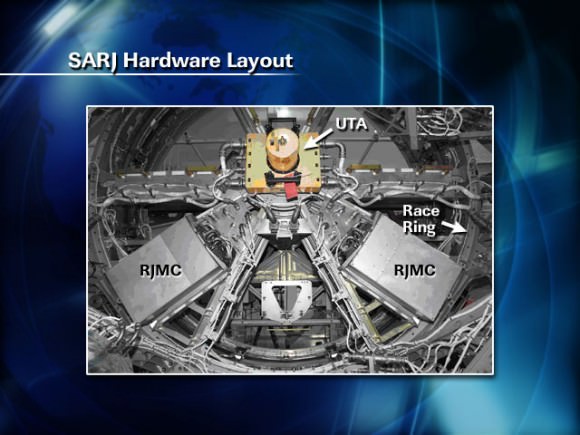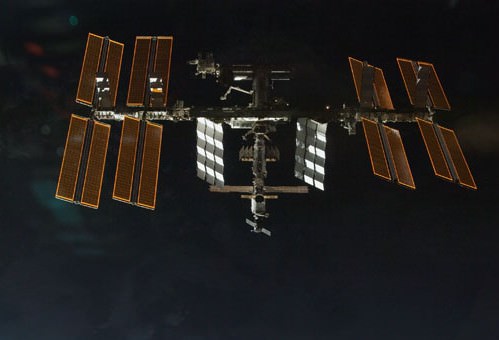[/caption]
How long can the International Space Station really operate – until 2020, or 2028 or beyond? I recently had the chance to talk with Mark Uhran, NASA’s Assistant Associate Administrator of the ISS. We were both attending a conference on water sustainability at Kennedy Space Center, but Uhran took the time to talk with me about the state of our space station, NASA’s new budget and how that might affect ISS operations, and — speaking of water — how is the urine recycling system working these days?
You can also hear an audio version of this interview on the March 28 edition of 365 Days of Astronomy.
Universe Today: How are things going as far the extension of the ISS? I heard there was recently a meeting with the international partners where they said it could be extended to 2028 if need be.

Mark Uhran: We’ve made the decision in the United States as part of the President’s budget proposal to Congress, so we’re over the hump here in the US. And then we began a series of meetings with the partners starting in Japan last week. Of course each of the partners has been working with us for the past 12-18 months, but they are fully prepared to approach their governments and ask for an extension. There are no technical obstacles to extending to at least 2020, and we’re also going to be doing an evaluation to what the ultimate lifetime of the ISS might be. That evaluation is in process. So we’re looking at whether we can go as long as 2028, but that remains to be seen.
Universe Today: Since we’re here talking about water, how are things going with the recycling system up there on the station. I know there have been some glitches here and there.
Uhran: The station has been a real testbed for developing regenerative water and air technologies. We knew at the time deploying these systems they would be in a testbed mode, and it would probably take about a year to shakedown all the systems and we are making steady progress towards doing just that. All the systems are working today – that’s not to say they will be working tomorrow. We certainly do expect them to go up and down throughout the course of the year as we fine tune them and work out the details. By the end of this year we hope to add a Sabatier (carbon dioxide reduction system) reactor that will allow us produce yet further water on orbit.
Hauling water is a very expensive proposition for us. Once the Sabatier is up there later this year, we’ll have basically the entire designed system deployed and I’m confident by this time next year we’ll have worked out all the filtration issues, the film formation issues, and precipitant issues and we’ll have this tuned so that it is basically available 90% of the time, which is an outstanding availability rate. So, this has been very worthwhile from our point of view not just because of the cost of hauling water to the space station but for the implications for human exploration beyond low Earth orbit.
Universe Today: The new NASA budget, which eliminates Constellation, how do you see that affecting space station operations?
Uhran: Well, space station is relatively small factor in that new budget. We’ve been extended, which is a major achievement from our point of view. But in terms of financial constraints, we are pretty well prepared now to go ahead and operate until the end of the decade, as well as to ramp up our research program on the station. With the assembly process being completed, the crew time now becomes available for supporting research. So most of our activities this year are geared towards repositioning our utilization program so that when the shuttle stops flying and the commercial cargo resupply services begin we are ready to ramp up that program aggressively, and that’s going very well.
Universe Today: I’ve been here at Kennedy Space Center for about a month and a half and a lot of the people here are talking about a possible extension for the space shuttle program. What are your thoughts on that?
Uhran: Well, the shuttle was certainly required for the assembly phase because we were hauling 20 metric ton elements up to orbit. It literally is the equivalent of a six-wheeler truck. But for the utilization phase, we can continue to maintain and operate the space station at much lower supply rates; typically 3 metric tons on a half a dozen to a dozen times a year. So there are other vehicles both that our international partners bring to the table as well as we’re hoping that the commercial US industry will demonstrate in the next 12-24 months that really will meet our needs once those are available. So although we’d all like to see the shuttles continue to fly forever, we really don’t have a requirement on space station for that kind of relatively heavy lift capability.

Universe Today: Another issue that has been sort of looming for the space station is the solar alpha rotary joints (SARJ). Any progress on understanding why they aren’t working as hoped?
Uhran: Well, they are working now. And the failure analysis has been completed. So we know the root causes of the problem. The most challenging mechanisms in any spacecraft system are rotating mechanisms. So the control moment gyros, the solar array rotary joints, the thermal radiator rotary joints – they are all rotating mechanisms. And we’re passing power through those mechanisms, which adds to the complexity. So we think that we have all these under control. It turned out with the SARJ that we have determined the cause of the failure, and we’re doing, really two things. We’re operating the system more gently – we ramp it up more slowly, we stop it more slowly. That doesn’t put as much load on the system. And we find that is applicable to all our systems. The more gently we can operate them the less loads they bear and the longer their lifetime. So we’ll be operating the system more gently and we’ll be lubricating them more regularly. So between those two approaches, we’re pretty confident we won’t have any more problems with the SARJ. We do have a couple of tricks in our pocket in the case that we do see further problems but we think we can get there with the two remedial actions we’ve got now.
Universe Today: To do the lubrication requires a spacewalk?
Uhran: It’s an EVA based activity, yes. It is relatively simple. And not even that time consuming. We were lubricating before, we’ll just increase the frequency.
Thanks to Mark Uhran for taking the time to talk with Universe Today. For more information on the International Space station, visit www.nasa.gov/station.


I’d like to know what the plan is for the eventual deorbit of the ISS. It’s going to come down someday, and it’s mighty big!